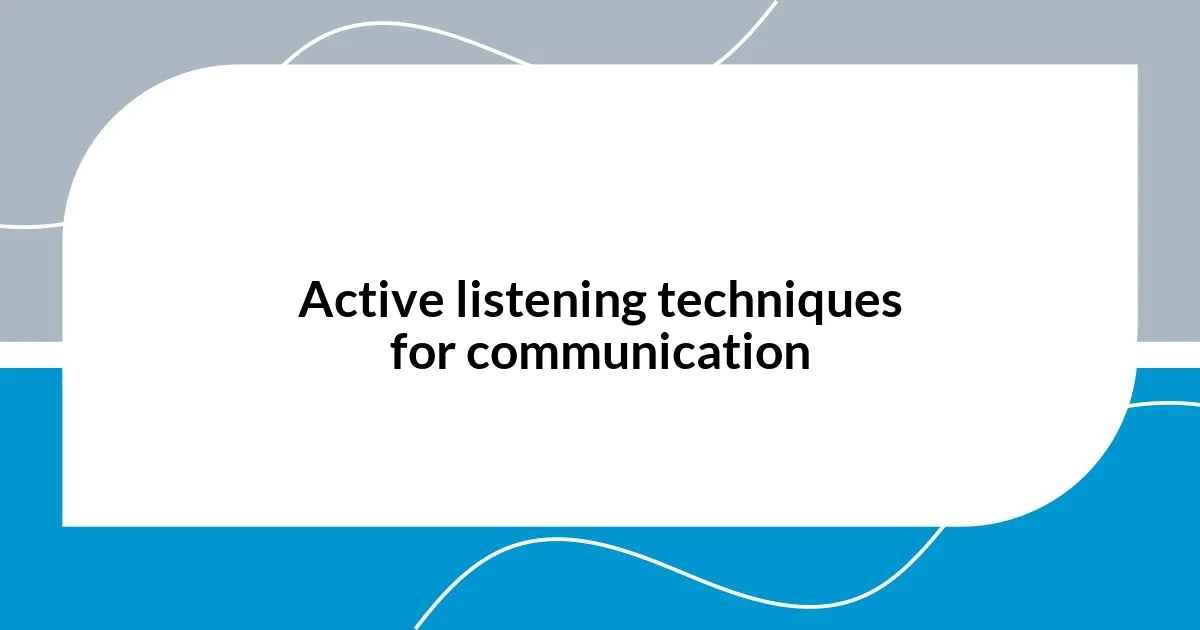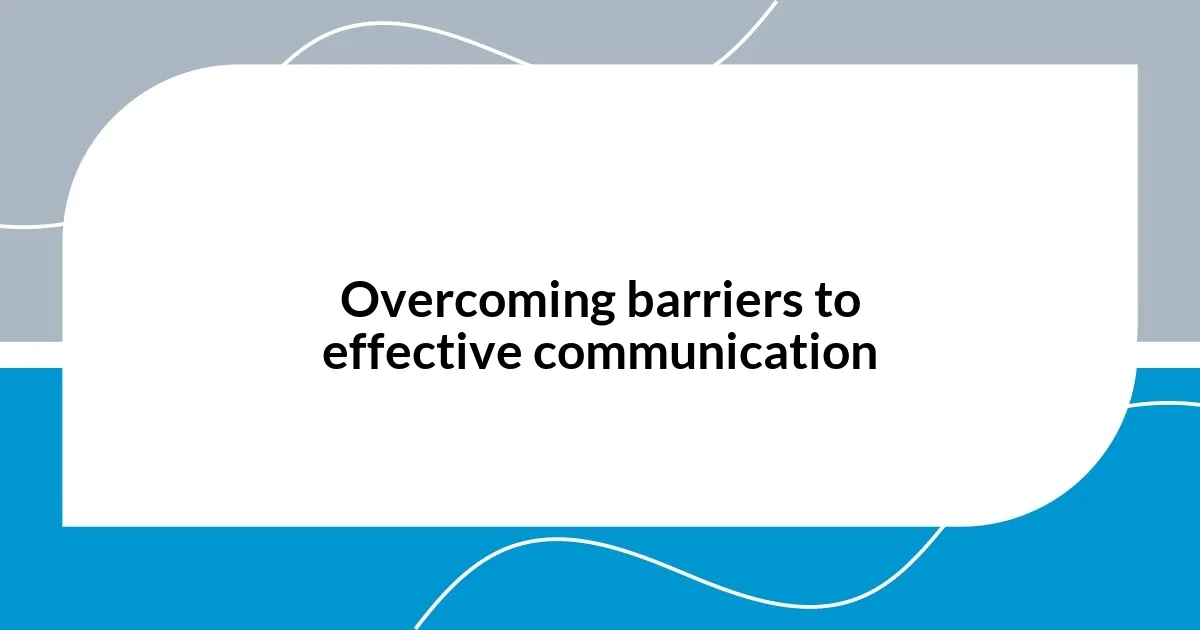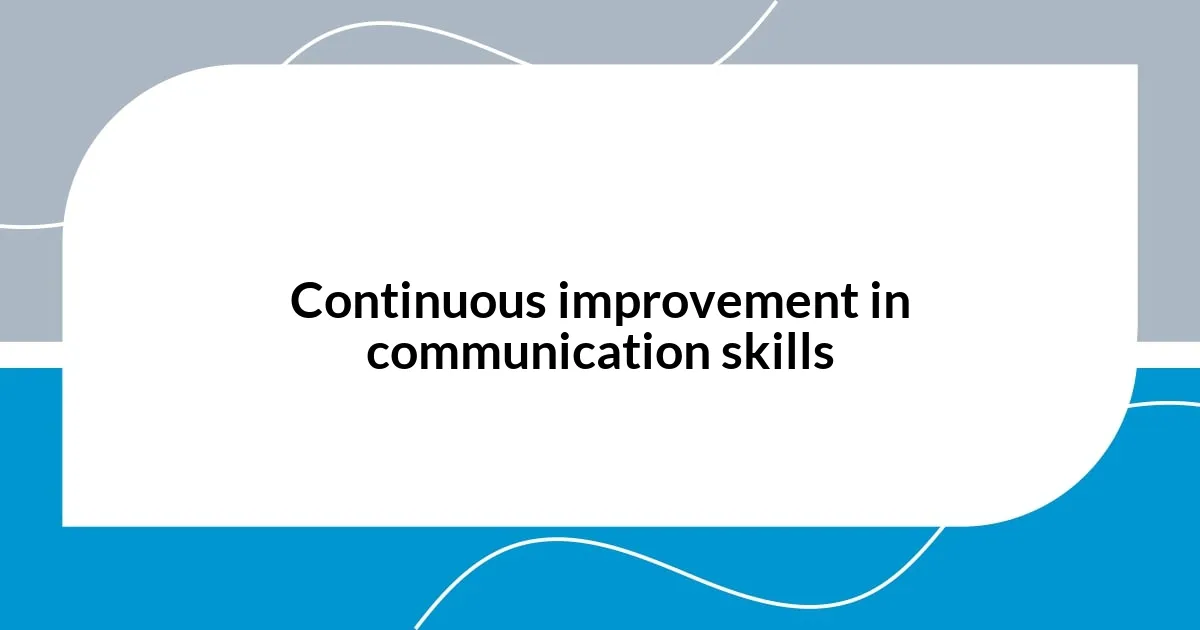Key takeaways:
- Effective communication involves active listening, clarity, and empathy, which deepen connections in personal and professional interactions.
- Nonverbal cues, like body language and facial expressions, significantly impact how messages are perceived and understood.
- Building rapport through personal connection, vulnerability, and humor fosters a safe environment for open dialogue.
- Continuous improvement in communication skills requires embracing feedback and maintaining curiosity through practice and exploration.

Understanding effective communication
Effective communication is more than just exchanging words; it’s about connecting on a deeper level. I remember a time when a simple conversation turned into a meaningful dialogue. A friend opened up about a struggle they were facing, and by actively listening, I could sense their vulnerability. It made me realize that truly understanding someone goes beyond the surface; it requires empathy and genuine interest.
When I think about how effective communication can transform relationships, I often ask myself: What truly makes a message resonate? It’s the clarity of thought combined with an openness that invites dialogue. I once had a challenging discussion with my team at work. Instead of going in with an agenda, I fostered an environment where everyone could voice their perspectives. The result? We found common ground and came up with innovative solutions that none of us had thought of before.
At times, I’ve seen misunderstandings arise from assumptions or incomplete information. It’s like playing a game of telephone. A message gets distorted along the way, leading to confusion even among close friends. I’ve learned that checking in and clarifying what someone means can create a bridge of understanding, making all the difference in both personal and professional interactions.

Key components of effective communication
Effective communication hinges on several key components that can significantly enhance connection. One core element is active listening. I recall a moment during a heated family discussion when I decided to pause and truly listen. It wasn’t just about hearing words; it was about understanding emotions behind them. This shift transformed the conversation and ultimately deepened our relationship.
Another vital component is clarity. When I was tasked with presenting a project at work, I realized early on that my audience wasn’t familiar with the technical jargon. I shifted my approach, simplifying my explanations and using relatable examples. This not only fostered engagement but also ensured everyone walked away with a solid understanding. It’s heartening to see how clarity can turn confusion into enthusiasm.
Lastly, empathy plays a profound role in communication. There was a time when a colleague felt overwhelmed, and their stress was palpable during our meeting. By acknowledging their feelings and validating their concerns, I noticed tension dissipate, allowing for more open dialogue. The emotional connection we share can often be the difference between discord and harmony in our interactions.
| Component | Explanation |
|---|---|
| Active Listening | Focusing fully on the speaker to understand their message and emotions. |
| Clarity | Ensuring your message is straightforward and easily understood. |
| Empathy | Connecting with others by recognizing and validating their feelings. |

Active listening techniques for communication
Active listening is a skill that can dramatically enhance communication, and I’ve found that it requires conscious effort. I remember attending a workshop where the instructor emphasized the power of silence. During exercises, I noticed how allowing a pause gave people the space to articulate their thoughts more clearly. It was an eye-opener—a moment where I realized that sometimes, not filling the gaps with noise can actually foster deeper understanding.
To practice active listening effectively, consider these techniques:
- Maintain Eye Contact: It shows you’re engaged and encourages the speaker to continue sharing.
- Nod and Use Affirmative Phrases: Simple affirmations like “I see” or “Go on” can prompt the speaker to delve deeper.
- Paraphrase What You Hear: This not only clarifies understanding but demonstrates that you value their input.
- Ask Open-Ended Questions: These encourage elaboration and show genuine interest in the speaker’s perspective.
- Avoid Interrupting: Letting the speaker finish their thoughts creates a more respectful and contemplative environment.
Recently, I made it a point to practice these techniques during a conversation with a friend who was experiencing a tough time. Instead of jumping in with my advice, I listened intently, reflecting back their feelings and asking questions that prompted them to expand on their experience. The depth of our conversation was astonishing, and I could feel the trust building. That interaction reinforced for me that active listening isn’t just about hearing words but about creating a safe space for real dialogue.

Nonverbal communication in practice
Nonverbal communication plays a crucial role in how we connect with others, often conveying messages that words alone cannot. I think back to a job interview where the candidate’s body language spoke volumes—confident posture and an open stance made a lasting impression. It made me wonder: how often do we underestimate the impact of a simple smile or a raised eyebrow in our interactions? These small gestures can create warmth and trust, setting a positive tone even before a word is spoken.
One time, during a community event, I noticed a woman trying to engage with a group. Despite her humorous words, her crossed arms and downcast eyes told a different story—she felt uncomfortable. I could sense the unease in the air. I approached her and offered a friendly nod and smile, which instantly shifted her demeanor. It struck me that our facial expressions and posture can either invite conversation or push others away. Isn’t it fascinating how our nonverbal cues can open doors or create barriers in ways we might not consciously realize?
Reflecting on my own experiences, I’ve come to appreciate the power of mirroring in conversations. When I subtly mimic a friend’s gestures or tone, it fosters a sense of connection that words sometimes fail to achieve. Just last week, while catching up with a close friend, I found myself leaning in and unconsciously mirroring her enthusiasm as she shared her recent adventures. It felt as if the entire conversation flowed effortlessly, highlighting that nonverbal communication isn’t just about the signals we send; it’s about the relationships we build through those unspoken connections. Don’t you think that tapping into these nonverbal elements could elevate our exchanges to a whole new level?

Building rapport through communication
Building rapport through communication is all about creating connections that feel genuine and safe. I once had a mentor who made it a point to remember the little details about me—my favorite hobbies, recent achievements, family stories. Each time we spoke, it felt like stepping into a space where my thoughts were valued. What’s interesting is how these small gestures can turn a routine meeting into a conversation that feels both intimate and important. Have you ever experienced that moment when someone remembers something personal about you? It’s like a warm hug in words.
I also believe that vulnerability plays a vital role in building rapport. There was a time when I shared a personal struggle with a colleague during lunch. I expected it to be a moment of discomfort, but instead, it opened a floodgate of trust. They reciprocated by sharing their own challenges, and suddenly, we were not just coworkers but allies in facing life’s ups and downs. It made me realize how showing a bit of ourselves can encourage others to do the same. Isn’t it fascinating how honesty fosters deeper connections almost effortlessly?
Moreover, humor can be an incredibly effective tool in rapport-building. I vividly remember a team meeting where I decided to lighten the mood with a light-hearted joke about our shared challenges. The laughter that followed not only eased tensions but also helped us bond as a team. In those moments of shared laughter, we became more than just a group of individuals; we transformed into a supportive community. Have you noticed that laughter has a way of breaking down barriers? In my experience, it creates an inviting atmosphere where open communication can thrive.

Overcoming barriers to effective communication
Overcoming barriers to effective communication often requires us to confront our assumptions and biases. I recall a situation during a team brainstorming session where a colleague spoke up with an unconventional idea. Initially, my first instinct was skepticism; I was quick to dismiss it because it didn’t align with my viewpoint. However, taking a moment to reflect, I realized that my tunnel vision was blocking potentially valuable insights. Have you ever caught yourself being too hasty in forming judgments? That experience taught me the importance of remaining open-minded.
Another barrier I’ve encountered is the challenge of language differences. I once participated in a multicultural workshop where English was not the first language for many attendees. I saw how easily misunderstandings arose, with people struggling to articulate their thoughts. One participant, in particular, seemed frustrated yet eager to share their perspective. I took the initiative to rephrase their point in simpler terms, and suddenly, another discussion emerged. It became clear to me that simplification and patience can bridge significant gaps in understanding. Isn’t it amazing how a little effort goes a long way in fostering clearer communication?
Emotional barriers can be equally daunting. I remember a time when I hesitated to express my true feelings during a critical conversation with a friend. My fear of judgment loomed large, but eventually, I took a deep breath and shared my feelings. Their reaction was incredibly supportive, creating a safe space for both of us to express our vulnerabilities. This experience highlighted to me that open communication can only happen when we dismantle the walls we build around ourselves. Have you noticed that vulnerability can be a powerful door to deeper understanding? It’s a reminder that we all have more in common than we might think.

Continuous improvement in communication skills
I’ve come to understand that continuous improvement in communication skills is a journey, not a destination. Recently, I decided to take a public speaking course. Initially, the thought of speaking in front of a crowd made my heart race, but with each session, not only did my confidence grow, but I also began to appreciate the nuances of effective communication. It’s fascinating how practice can turn fear into excitement—have you ever experienced that shift?
A valuable lesson I learned is the importance of feedback. After a presentation, I sought out honest critiques from my peers. At first, it stung to hear areas I needed to improve on, but embracing constructive criticism became a catalyst for my growth. I realized that the willingness to listen and adapt is a key component in refining communication skills. Does seeking feedback feel daunting to you? I can assure you, it’s a crucial step in the learning process.
Reflecting on past experiences, I recognize that staying curious is essential for continuous improvement. For instance, I often read books or articles on communication strategies. Each new insight leads me to experiment with different techniques, whether it’s adjusting my tone or trying out storytelling elements in conversations. This constant exploration keeps my communication fresh and engaging. Have you found inspiration in unexpected places to enhance your own skills? Embracing that curiosity can open up a world of possibilities.